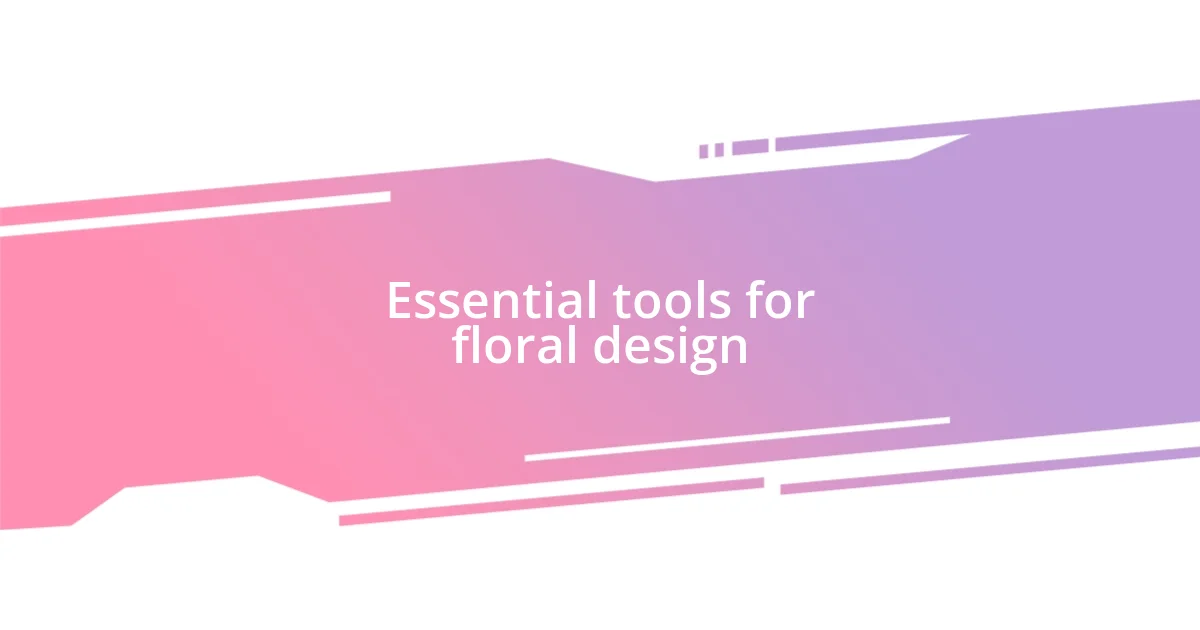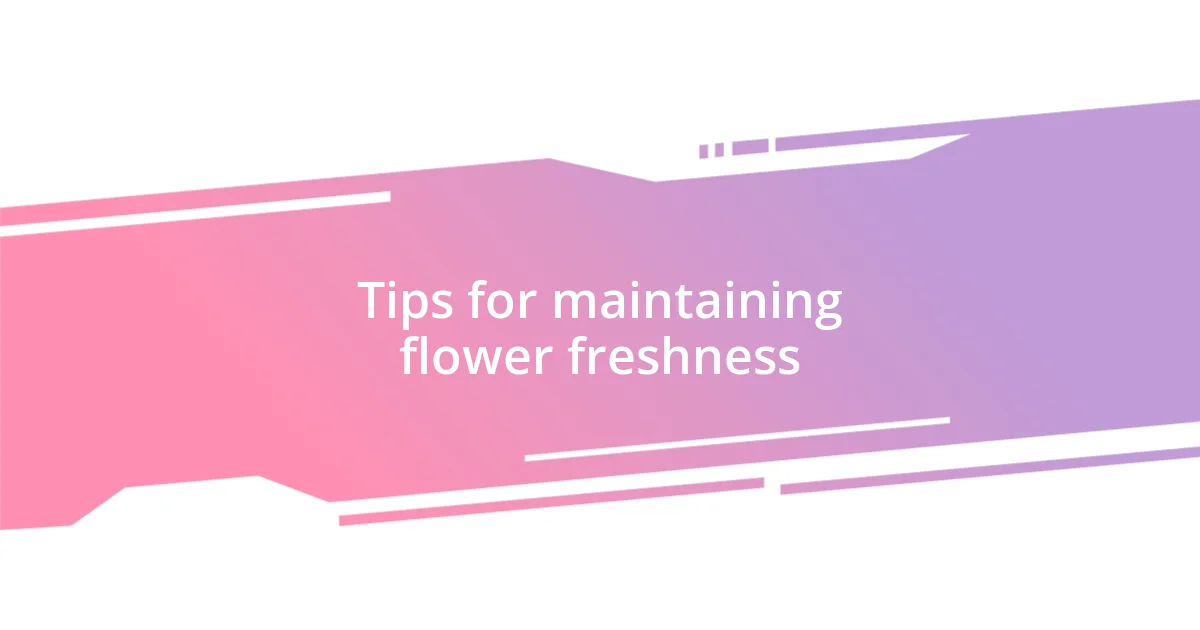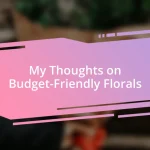Key takeaways:
- The author’s passion for floral design was sparked by a connection to simple flowers, leading to valuable emotional expressions through arrangements.
- Essential tools for floral design include floral scissors, wire cutters, and foam, which enhance creativity and efficiency in creating stunning displays.
- Techniques like layering, color blocking, and balance are crucial for creating visually impactful arrangements and maintaining flower freshness is vital for longevity.

My journey into floral design
I still remember the first time I picked up a bunch of daisies at a local market. Their vibrant colors and delicate shapes stirred something within me, and it’s funny to think how those simple flowers ignited my passion for floral design. Have you ever felt that connection to something so seemingly ordinary that it transforms your perspective?
As I began experimenting with different arrangements, I often found myself lost in the process, like painting with nature’s palette. I recall an afternoon spent preparing flowers for a friend’s wedding; it was a whirlwind of excitement and nerves. When I saw her face light up upon seeing the arrangements, I realized how profoundly flowers can communicate emotions—happiness, love, even sympathy.
There were moments, of course, when I struggled—like the time I attempted a complex centerpiece that ended up looking more chaotic than captivating. But isn’t that part of the journey? Each misstep brought valuable lessons and an appreciation for the intricacies of floral design. It’s through these trials that I learned my unique style, becoming more confident in combining colors and textures.

Essential tools for floral design
When it comes to floral design, having the right tools is essential to bring your creative vision to life. Over the years, I’ve collected a few trusty items that truly make a difference. I remember the excitement I felt when I invested in a solid pair of floral scissors. They weren’t just a tool; they became an extension of my hand, allowing me to create intricate cuts that changed how I approached each arrangement.
Here’s a list of essential tools that I’ve found indispensable in my floral design toolkit:
- Floral scissors: For precise cutting and better preservation of stems.
- Wire cutters: Perfect for cutting through thicker stems and floral wire.
- Floral tape: Ideal for securing arrangements and creating structure.
- Vase and container choices: Different shapes influence the design dynamics, so I always keep a variety on hand.
- Floral foam: A game changer for holding stems in place, especially in bigger displays.
- Wires and picks: Great for supporting fragile stems or creating height in arrangements.
Each of these tools contributes to the overall flow of creativity and efficiency. It’s not just about having them, but how they empower me to express my ideas through floral art. When I finally mastered the use of floral foam, I couldn’t contain my excitement; it opened up a whole new world of arrangement possibilities, allowing me to play with different forms that were previously challenging.

Techniques for creating stunning arrangements
When I create floral arrangements, one technique I cherish is layering. It’s like creating a visual story where each flower plays a part. I remember crafting a display for a local art gallery; the layered effect allowed the vibrant hues of tulips to shine against the subtle tones of eucalyptus. This depth not only gives character but often evokes a sense of movement, drawing the eye in and inviting people to explore the arrangement closely.
Another essential technique is color blocking, which can be remarkably effective. I learned this while designing arrangements for a vibrant summer wedding. Choosing bold colors and placing them next to each other created a striking contrast that made the flowers pop. I still recall the guests’ faces when they saw the centerpieces; it was pure joy. This method takes a bit of courage, but the visual impact is well worth the risk.
Lastly, I can’t stress the importance of balance enough. Balancing elements—like height, color, and texture—can significantly change how an arrangement is perceived. I once designed a large piece that was top-heavy and it felt off. After redistributing the flowers, it transformed entirely. Now, I always step back and assess the arrangement from various angles, ensuring it feels harmonious and well-designed. Practicing these three techniques has truly enriched my floral design journey.
| Technique | Description |
|---|---|
| Layering | Creating depth by arranging flowers in layers to draw attention and evoke movement. |
| Color Blocking | Using bold contrasting colors side by side to create a striking visual impact. |
| Balance | Ensuring harmony in the arrangement by distributing height, color, and texture evenly. |

Tips for maintaining flower freshness
When it comes to keeping flowers fresh, I’ve learned that water temperature makes a noticeable difference. I always start with lukewarm water, especially for woody stems like roses; it helps the flowers absorb the water more efficiently. I remember a time when I used cold water out of habit, and the blooms just didn’t look as vibrant as they could have. It’s amazing how such a simple change can lead to a striking improvement in freshness.
Regularly changing the water is another crucial tip I swear by. Every few days, I swap out the old water and give the stems a fresh cut. This not only keeps bacteria at bay but allows the stems to drink deeply again. Have you ever noticed how quickly stagnant water can turn? There’s something about the smell that hits you as soon as you change it—a freshness that revitalizes both the flowers and your space. It’s a ritual, really, one that brings me closer to my floral creations.
Lastly, I can’t stress the importance of adding flower food. It sounds elementary, yet I was surprised at how much it enhances longevity. I recall an instance when I forgot to use it for a bouquet I gifted a friend, and the difference was stark. Without the nutrients, they wilted within days instead of lasting weeks. Now, I always keep a stash of flower food and ensure my arrangements get their nutritional boost. After all, when you put in the effort to create beauty, why not help it last as long as possible?

Showcasing arrangements for events
When it comes to showcasing arrangements for events, I’ve found that presentation matters just as much as the flowers themselves. For a recent birthday celebration I decorated, I decided to use clear glass vases that not only highlighted the blooms but also allowed the guests to see the submerged greenery at the bottom. It created an eye-catching focal point that had people stopping to admire every aspect of the arrangements. I remember the delighted laughter that filled the room as guests connected with the natural beauty, and it reminded me just how crucial the right choice of container can be in elevating the entire display.
Another memorable experience was during a corporate event where I used draping fabric alongside my floral designs. The soft, flowing fabric wrapped around the tables added an elegance that complemented the arrangements perfectly. It was a beautiful evening, and as I watched attendees interact amid the flowers, I couldn’t help but feel a sense of pride. This combination not only presented the arrangements beautifully but also enhanced the event’s overall aesthetic, creating a warm and inviting atmosphere.
I often ask myself how the little details impact an event’s ambiance, and my answer always circles back to the power of lighting. For example, during an evening wedding I designed for, I strategically placed uplighting around the arrangements to highlight their textures and colors. The way the flowers glowed against the soft, ambient lighting transformed the entire space into something magical. I witnessed guests stopping in their tracks, captivated by the interplay of light and floral beauty. It’s these elements that truly bring floral designs to life and make every event unforgettable.














